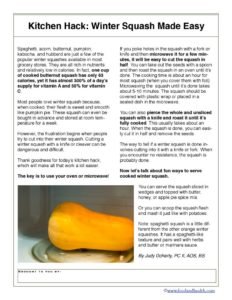Winter Squash Made Easy
Spaghetti, acorn, butternut, pumpkin, kabocha, and hubbard are just a few of the popular winter squashes available in most grocery stores. They are all rich in nutrients and relatively low in calories. In fact, one cup of cooked butternut squash has only 63 calories, yet it has almost 300% of a day’s supply for vitamin A and 50% for vitamin C.Most people love winter squash because, when cooked, their flesh is sweet and smooth like pumpkin pie. These squash can even be bought in advance and stored at room temperature for a week.However, the frustration begins when people try to cut into their winter squash. Cutting a winter squash with a knife or cleaver can be dangerous and difficult.Thank goodness for today’s kitchen hack, which will make all that work a lot easier.The key is to use your oven or microwave!If you poke holes in the squash with a fork or knife and then microwave it for a few minutes, it will be easy to cut the squash in half. You can take out the seeds with a spoon and then roast the squash in an oven until it’s done. The cooking time is about an hour for most squash (when you cover them with foil). Microwaving the squash until it’s done takes about 5-10 minutes. The squash should be covered with plastic wrap or placed in a sealed dish in the microwave.You can also pierce the whole and unsliced squash with a knife and roast it until it’s fully cooked. This usually takes about an hour. When the squash is done, you can easily cut it in half and remove the seeds.The way to tell if a winter squash is done involves cutting into it with a knife or fork. When you encounter no resistance, the squash is probably done.Now let’s talk about fun ways to serve cooked winter squash.You can serve the squash sliced in wedges and topped with butter, honey, or apple pie spice mix.Or you can scoop the squash flesh and mash it just like with potatoes.Note: spaghetti squash is a little different from the other orange winter squashes. It has a spaghetti-like texture and pairs well with herbs and butter or marinara sauce.By Judy Doherty, PC II, AOS, BSCheck out this printable handout of today's post!


